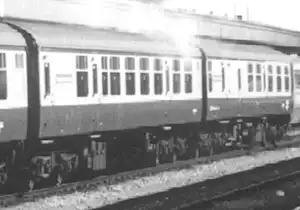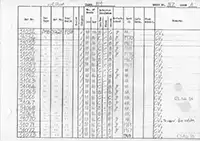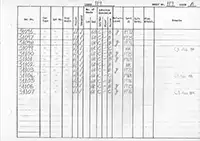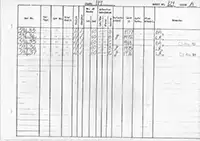Class 119 GRC&W Cross-Country 3-car DMUs
Description

GRC&W took the existing Cross-Country design (the Swindon Class 120s) and put a standard Derby design on the front. Other differences are:
| 119 | 120 | |
| Roof vents | More | Less |
| Gutters at gangway ends | Angled 45 degrees | Slight curve |
| Gangways | Midland Scissors | WR-Suspended |
| Bogies | Derby design (DD10) | Swindon design (DD1) |
There were also differences to the underframe layout.
The image shows a page from a brochure produced by the manufacturer.
In the early 1960s the outside swing links on the bogies were removed.
Large round buffers were normally fitted, although other types could be found from time to time. An example is 51091 which was noted in 1976 to have an oval (left) and cut (right) on the cab end.
Sets were fitted with WR ATC from new. In the early 1970s normal AWS was also fitted, making them 'Dual AWS', and a few years later the WR ATC gear was removed.
Inside, the interior layout was almost identical to the Class 120s, although there were differences in the trim material used. Dark timber edging strips for the green fleck formica panels was used rather than alloy beading, and in second class vinyl blinds were used rather than curtains. This gave a darker and more austere interior design.

The photo by Nick Lander shows inside a set in the 1970's, still retaining its original interior.
While built with AEC engines, in 1976 power cars started appearing with Leyland engines. Both types were rated at 150hp and had identical mounts, so the change was relatively straightforward. It would be almost ten years before all the vehicles were treated, the last handful being 51056/64/74 and 51086/98/102 circa 1984.
Although vehicles were never formally part of the 'Refurbishment' scheme many vehicles were rebuilt internally after the asbestos, which had been sprayed on to a depth of an inch, had been removed. These had new panelling and fluorescent lighting, new seat covers and linoleum to the standard BR blue/grey pattern.
Around the same time the now out of use two-character route indicator was plated over. Some of the power cars that survived till the end would receive headlamps in this position.
Another change was the AEC engines being replaced by Leyland engines. The image shows the underframe equipment in the Driver's side of a DMS with a Leyland engine fitted.

In later years some sets had all the roof vents removed, normally leaving just one at each end of the vehicle.
Reading - Gatwick sets

In the early 1980s the sets dedicated to the Reading - Gatwick Airport service had the redundant buffet area converted to form additional luggage space, the brake van was also dedicated to this, and both areas were marked on the exterior as a 'Passenger Luggage Stowage Area'.
Asbestos Removal
The vehicles were built with blue asbestos on the walls and ceilings, some vehicles had this removed.
The pages below are from a vehicle log kept by the RTC at Derby dated circa 1984 which included the asbestos status for each vehicle.
The codes for the asbestos columns are: / not built with blue asbestos; B - blue asbestos; and C - removed. In the Refurbished column g means refurbished for Reading-Gatwick service, blank not refurbished. In the Last C1 column NR means no record of a C1 overhaul. In the remarks column CV means corridor van (cage fitted); BA means "Buffet counter and area at one end of car"; and LR means "Luggage racks at one end of car".
Summary
Description
Liveries
GRCW Works Pictures
BR Works Pictures
Diagrams & Design Codes
Numbering & Driving Inst.
Operations
Images
Details about preserved Class 119s can be found here.
Thanks to Jim Poor (Gloucester Railcar Trust) for additional information.







